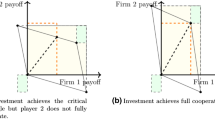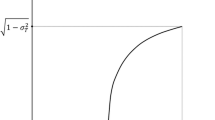Abstract
We extend the results of Feng and Hendrikse (2012) by investigating the relationship between cognition and incentives in cooperatives versus investor-owned firms (IOFs) in a multi-tasking principal-agent model. The principal chooses the incentive intensity as well as the precision of monitoring, while the agent chooses the activities. We establish that a cooperative is uniquely efficient when either the synergy between the upstream and downstream activities or the knowledgeability of the members regarding the cooperative enterprise is sufficiently high.
Access this chapter
Tax calculation will be finalised at checkout
Purchases are for personal use only
Similar content being viewed by others
Notes
- 1.
Other approaches regarding the analysis of the efficiency of cooperatives from a bounded cognition perspective are screening errors (Hendrikse 1998), bias (Deng and Hendrikse 2014), inaccurate recognition of the environment (Hendrikse 2021), partitioning (Hendrikse 2021), and local neighborhoods (Deng and Hendrikse 2022).
- 2.
We have analyzed a correlation parameter regarding the variances, but the results remain qualitatively the same. Additionally, this parameter would play the same role as the synergy parameter k, but with more complicated expressions. So we assume that the variances are independent.
- 3.
All proofs in this section can be found in the Appendix.
- 4.
The figures regarding the surplus of each governance structure are presented in the Appendix.
- 5.
The closed form result is presented in the Appendix.
References
Abate GT, Franceconi GN, Getnet K (2014) Impact of agricultural cooperatives on smallholders’ technical efficiency: empirical evidence from Ethiopia. Ann Public Coop Econ 85:257–286. https://doi.org/10.1111/apce.12035
Arad A, Rubinstein A (2019) Multidimensional reasoning in games: framework, equilibrium, and applications. Am Econ J Microecon 11:285–318. https://doi.org/10.1257/mic.20170322
Arrow KJ (1974) The limits of organization. W.W. Norton, New York
Bajwa SU, Shahzad K, Aslam H (2017) Exploring big five personality traits and gender as predictors of entrepreneurs’ cognitive adaptability. J Model Manag 12:143–161. https://doi.org/10.1108/jm2-04-2014-0026
Beaman L, BenYishay A, Magruder J, Mobarak AM (2021) Can network theory-based targeting increase technology adoption? Am Econ Rev 111:1918–1943. https://doi.org/10.1257/aer.20200295
Bijman J, Iliopoulos C (2014) Farmers’ cooperatives in the EU: policies, strategies, and organization. Ann Public Coop Econ 85:497–508. https://doi.org/10.1111/apce.12048
Bolton P, Dewatripont M (2005) Contract theory. MIT Press, Cambridge
Cao X, Ouyang T, Balozian P, Zhang S (2020) The role of managerial cognitive capability in developing a sustainable innovation ecosystem: a case study of Xiaomi. Sustainability 12:7176. https://doi.org/10.3390/su12177176
Cook ML (1994) The role of management behavior in agricultural cooperatives. J Agric Coop 9:42–58
Co-operatives UK (2021) Co-op economy 2021: a report on the UK’s co-operative sector. Co-op Economy. https://www.uk.coop/sites/default/files/202106/Economy%202021_1.pdfk.coop. Accessed 10 Jan 2022
Cyert RM, March JG (1963) A behavioral theory of the firm. Martino, Eastford
D’Amato A, Festa G, Dhir A, Rossi M (2021) Cooperatives’ performance relative to investor-owned firms: a non-distorted approach for the wine sector. Br Food J 124:35–52. https://doi.org/10.1108/bfj-03-2021-0275
Deng W, Hendrikse GWJ (2014) Managerial vision bias and cooperative governance. Eur Rev Agric Econ 42:797–828. https://doi.org/10.1093/erae/jbv017
Deng W, Hendrikse GWJ (2022) On the evolution of product portfolio of cooperatives versus IOFs: an agent-based analysis of the single origin constraint. In: Hendrikse GWJ et al (eds) Networks in international business. Springer, Cham
Dessein W, Santos T (2021) Managerial style and attention. Am Econ J Microecon 13:372–403. https://doi.org/10.1257/mic.20190025
Dixit A (2002) Incentives and organizations in the public sector: an interpretative review. J Hum Resour 37:696. https://doi.org/10.2307/3069614
Feng L, Hendrikse GWJ (2012) Chain interdependencies, measurement problems and efficient governance structure: cooperatives versus publicly listed firms. Eur Rev Agric Econ 39:241–255. https://doi.org/10.1093/erae/jbr007
García-Jimeno C, Iglesias A, Yildirim P (2022) Information networks and collective action: Evidence from the women’s temperance crusade. Am Econ Rev 112:41–80. https://doi.org/10.1257/aer.20180124
Gibbons R, Roberts J (2012) The handbook of organizational economics. Princeton University Press, Princeton, NJ
Gibbons R, LiCalzi M, Warglien M (2021) What situation is this? Shared frames and collective performance. Strateg Sci 6:124–140. https://doi.org/10.1287/stsc.2020.0120
Goeree JK, Louis P (2021) M equilibrium: a theory of beliefs and choices in games. Am Econ Rev 111:4002–4045. https://doi.org/10.1257/aer.20201683
Gong TC, Battese GE, Villano RA (2019) Family farms plus cooperatives in China: technical efficiency in crop production. J Asian Econ 64:101129. https://doi.org/10.1016/j.asieco.2019.07.002
Helfat CE, Peteraf MA (2015) Managerial cognitive capabilities and the microfoundations of dynamic capabilities. Strateg Manag J 36:831–850. https://doi.org/10.1002/smj.2247
Hendrikse GWJ (1998) Screening, competition and the choice of the cooperative as an organisational form. J Agric Econ 49:202–217. https://doi.org/10.1111/j.1477-9552.1998.tb01264.x
Hendrikse GWJ (2021) Modelling cooperative governance: what have we learned about Boards of Directors?. In: Filippi M (ed) Cooperatives in transition facing crisis, ICA CCR EU 2021 Conference proceedings, pp 243–257
Holmstrom B, Milgrom P (1991) Multitask principal–agent analyses: incentive contracts, asset ownership, and job design. J Law Econ Organ 7:24–52. https://doi.org/10.1093/jleo/7.special_issue.24
Kumbure MM, Tarkiainen A, Luukka P, Stoklasa J, Jantunen A (2020) Relation between managerial cognition and industrial performance: an assessment with strategic cognitive maps using fuzzy-set qualitative comparative analysis. J Bus Res 114:160–172. https://doi.org/10.1016/j.jbusres.2020.04.001
LeVay C (1983) Agricultural co-operative theory: a review. J Agric Econ 34:1–44. https://doi.org/10.1111/j.1477-9552.1983.tb00973.x
Manouchehrabadi B, Letizia P, Hendrikse GWJ (2021) Governance of collective entrepreneurship. J Econ Behav Organ 185:370–389. https://doi.org/10.1016/j.jebo.2021.02.012
Milgrom P, Roberts J (1992) Economics, organization and management. Prentice Hall International, Upper Saddle River, NJ
Silva LF, Morello T (2021) Is there a trade-off between efficiency and cooperativism? Evidence from Brazilian worker cooperatives. J Co-op Organ Manag 9:100136. https://doi.org/10.1016/j.jcom.2021.100136
Simon HA (1947) Administrative behavior: a study of decision-making processes in administrative organizations. Free Press, New York
Simon HA, Newell A (1971) Human problem solving: The state of the theory in 1970. Am Psychol 26:145–159. https://doi.org/10.1037/h0030806
Author information
Authors and Affiliations
Corresponding author
Editor information
Editors and Affiliations
Appendix
Appendix
A. Total Surplus Figures
The figures representing the total surplus of the upstream IOF, the downstream IOF, and the cooperative, respectively (Fig. 7):
B. Proofs of Comparative Statics Results
Denote \( \left[\left({f}_u{g}_u-k{f}_d{g}_u\right)-\sqrt{2r}\left(1-{k}^2\right)W\right] \) as F > 0.
So as
In terms of \( \frac{\partial E\left(\pi +U\right)}{\partial k} \), for −1 < k < 0 and when k is increasing, (fu − kfd) is decreasing, \( \sqrt{2\left(1-{k}^2\right)} \) is increasing, \( \sqrt{r\left(1-{k}^2\right)} \) is increasing, so the overall effect is decreasing, \( \frac{\partial E\left(\pi +U\right)}{\partial k}<0 \); denote \( \left(\frac{f_u-k{f}_d}{\sqrt{2\left(1-{k}^2\right)}}-\frac{\sqrt{r\left(1-{k}^2\right)}}{g_u}W\right) \) as T,
C. Efficiency Numerical Illustrations
We would like to investigate under which condition the difference between the cooperative’s total surplus to the sum of the two IOFs can be positive (indicating the cooperative is efficient). Here we denote H as the difference, and H has the form below
To solve for H > 0, we will have a function describing the relations between ωud and k.
First, we directly calculate the above function and report the result from Matlab. ωud(k) should be in the following interval to make the cooperative efficient:
\( \mathrm{where}\ {\sigma}_1=\sqrt{2}\;w\;\sqrt{2-2\;{k}^2}\;{\sigma}_4;{\sigma}_2=w\;\sqrt{2-2\;{k}^2}\;{\sigma}_4;{\sigma}_3=\sqrt{2-2\;{k}^2}\;{\sigma}_4 \); \( {\sigma}_4=\sqrt{-r\;\left({k}^2-1\right)} \); a and b are functions of the productivity and performance measurement parameters.
The explicit result is too lengthy to analyze. Two numerical examples are presented to illustrate various insights. The first example demonstrates that stronger cognition capacity of the upstream party offsets the negative effects of lower chain interdependency, allowing cooperatives to outperform the IOFs; the second example shows that when cognitive capacity is low, stronger interdependency within the industry still allows cooperatives to be more efficient (Fig. 8).
We set values for variables for both examples as follows: \( {f}_u={f}_d=20;{g}_u={g}_d=1;{\omega}_{uu}={\omega}_{dd}=4;r=0.5,\frac{f_u-\sqrt{f_u^2+{f}_d^2}}{f_d}=1-\sqrt{2} \).
For point A, we set ωud = 0.16 < ωuu = ωdd, and \( k=-0.4>\frac{f_u-\sqrt{f_u^2+{f}_d^2}}{f_d} \). H = 2.34 > 0. Table 1 below shows the values of other variables.
The values in the second example, determining point B, are ωud = 9 > ωuu = ωdd, and \( k=-0.5<\frac{f_u-\sqrt{f_u^2+{f}_d^2}}{f_d} \). H = 3.04 > 0. (\( \sqrt{\omega_{ud}}>\frac{g_u}{\sqrt{2r}\left(1-{k}^2\right)}\left[\left({f}_u-k{f}_d\right)-\sqrt{f_u^2+{f}_d^2}\right]-\sqrt{\omega_{uu}}, \) so B is above the curve.). Table 2 below shows the values of other variables.
A is an efficient point for the cooperative, even though the chain interdependency is not so high. This is evidence of the cognition advantage of the cooperative. Without introducing the monitoring intensity principle, efficient point A would never be accessible. But a low enough ωud (indicating a high enough cognitive ability, due to innovation and information sharing for instance) can compensate such a high k, leading the cooperative to be efficient in the end.
B is another efficient point for the cooperative, even with a much lower cognitive ability. It justifies the interdependency advantages of the cooperative. In an environment that the processor of the cooperative knows so little, but the chain interdependency is high enough to cover, then the IOFs can still be dominated.
Here we would like to highlight the mechanism behind. Recall that the expected value of the total surplus is the sum of the principal’s payoff and CEO’s payoff: \( E\left(\pi +U\right)=y-c\left({a}_{iu},{a}_{id}\right)-\frac{1}{2}r\mathrm{Var}(w)-M(V) \). In the first example, a higher k directly increases the costs of the activities and indirectly drops the activities, causing the total output y to decrease, but a much lower ωud reduces the monitoring costs and thus the risk aversions more compared to the IOFs, leading to an efficient cooperative. In Table 1, the sum of the cooperative activities is slightly less than the IOFs’ activities, but the sum of the variances is just the opposite, especially for the downstream variance. This justifies that the cognition effect matters more in this example, and by reducing the variances-related costs, the cooperative is performing better than the two IOFs.
The other example is just the other way around. When ωud increases, the monitoring costs and risk aversions rise, but a lower k will trigger higher activities and output to compensate more. In Table 2, the variances are kind of similar, but the sum of the cooperative activities is larger than the IOFs’ activities. It verifies that the chain interdependency effect counts more in this case, and by motivating more activities, the cooperative can be efficient.
Rights and permissions
Copyright information
© 2023 The Author(s), under exclusive license to Springer Nature Switzerland AG
About this chapter
Cite this chapter
Wei, A., Hendrikse, G.W. (2023). Cognition and Incentives in Cooperatives. In: Hendrikse, G.W., Cliquet, G., Hajdini, I., Raha, A., Windsperger, J. (eds) Networks in International Business. Contributions to Management Science. Springer, Cham. https://doi.org/10.1007/978-3-031-18134-4_4
Download citation
DOI: https://doi.org/10.1007/978-3-031-18134-4_4
Published:
Publisher Name: Springer, Cham
Print ISBN: 978-3-031-18133-7
Online ISBN: 978-3-031-18134-4
eBook Packages: Business and ManagementBusiness and Management (R0)






